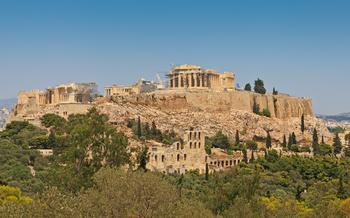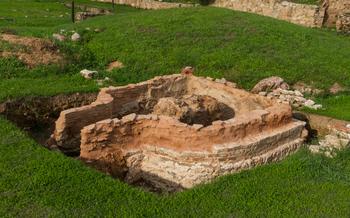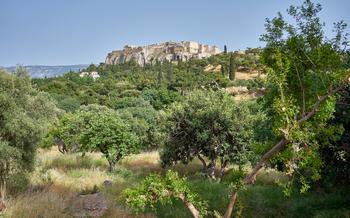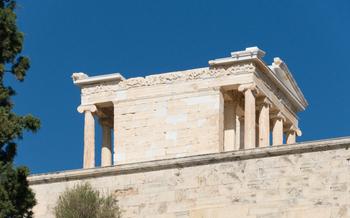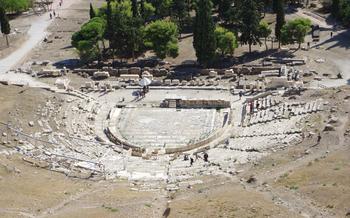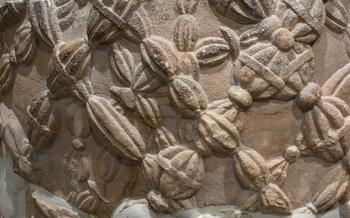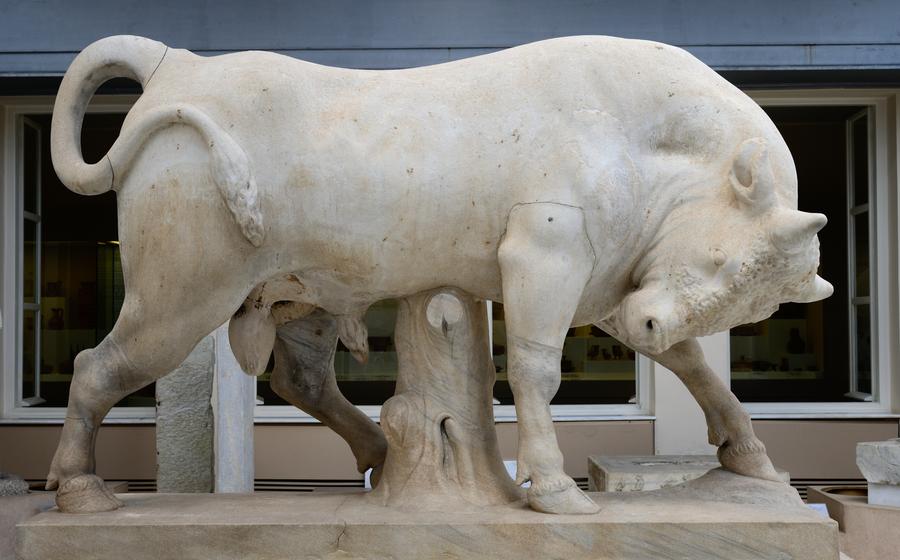
Kerameikos Museum
- A Journey Through Ancient Souls: Unveiling the Kerameikos Museum
- Location and Accessibility
- A Haven for History Buffs: Delving into the Museum's Collection
- The Sacred Gateway: Exploring the Necropolis of Kerameikos
- From Grief to Glory: Tracing the Evolution of Funerary Art
- Voices from the Past: Uncovering the Stories Behind the Graves
- Honoring the Dead: Ancient Athenian Funerary Rituals
- The Potter's Quarter: Unveiling the Artisans' Legacy
- A Stroll Through Time: The Sacred Road and Its Surroundings
- The Sacred Spring: A Place of Purification and Ritual
- The Wall of Themistocles: A Fortified Legacy
- The Pompeion: Preparing for Sacred Processions
- The Altar of the Twelve Gods: A Sacred Gathering Place
- The Stoa Hermou: A Place for Philosophers and Scholars
- The Temple of Athena: Honoring the Goddess of Wisdom
- Insider Tip: Uncrowded Exploration and Photography
A Journey Through Ancient Souls: Unveiling the Kerameikos Museum
Nestled in the heart of Athens, the Kerameikos Museum stands as a testament to the rich history and vibrant culture of ancient Greece. Once a bustling quarter known for its flourishing pottery industry, Kerameikos has been transformed into a fascinating museum that encapsulates the essence of ancient Athenian life.
The museum's collection boasts an impressive array of artifacts excavated from the surrounding area, providing visitors with a glimpse into the daily lives, beliefs, and customs of our ancient ancestors. Prepare to be transported back in time as you wander through the exhibits, discovering the stories of those who walked the streets of Athens centuries ago.
Location and Accessibility
The Kerameikos Museum is conveniently located in the heart of Athens, within walking distance of several other significant historical sites, including the Acropolis and the Ancient Agora. The museum is easily accessible by public transportation, with both metro and bus lines stopping nearby.
A Haven for History Buffs: Delving into the Museum's Collection
Housing a treasure trove of artifacts excavated from the ancient necropolis and surrounding areas, the Kerameikos Museum provides an unparalleled glimpse into the lives and customs of ancient Athenians. From intricate pottery and sculptures to funerary inscriptions, each artifact tells a story of the people who once called this city their home.
Among the highlights of the museum's collection are the numerous pottery vessels that showcase the exceptional craftsmanship of ancient Athenian potters. These vessels range from simple household items to elaborately decorated vases, each adorned with scenes from mythology, everyday life, or religious rituals.
The museum also boasts an impressive collection of sculptures, ranging from small terracotta figurines to life-size marble statues. These sculptures depict a variety of subjects, including gods, heroes, and ordinary citizens, offering a glimpse into the artistic styles and techniques of the ancient Athenian world.
Of particular interest are the funerary inscriptions that provide valuable insights into the lives and identities of the deceased. These inscriptions often include the names, occupations, and personal histories of the individuals, as well as poignant expressions of grief and remembrance.
The Sacred Gateway: Exploring the Necropolis of Kerameikos
The Kerameikos necropolis, located adjacent to the museum, served as the primary burial ground for ancient Athens. Strolling through this ancient cemetery, visitors are transported back in time, surrounded by an array of tombstones and funerary monuments that offer a unique glimpse into ancient burial practices.
These tombs, each bearing its own story, provide valuable insights into the lives and deaths of ancient Athenians. From simple markers to elaborate sculptures, the tombstones showcase a range of artistic styles and symbolism, reflecting the evolving attitudes towards death and the afterlife.
The necropolis also features a number of larger funerary monuments, such as family tombs and mausoleums. These structures, often adorned with intricate carvings and inscriptions, demonstrate the importance placed on honoring the dead in ancient Athens.
Exploring the Kerameikos necropolis is like stepping into a silent city of the dead, where each tombstone whispers tales of lives long past. It is a place where history comes alive, inviting visitors to contemplate the mortality and legacy of ancient Athenians.
From Grief to Glory: Tracing the Evolution of Funerary Art
The tombstones and funerary monuments at the Kerameikos Museum showcase a fascinating evolution of funerary art. In the early years, tombstones were simple markers, often adorned with little more than the name of the deceased. However, over time, these markers became increasingly elaborate, reflecting the growing wealth and artistry of ancient Athens.
The transition from simple markers to elaborate sculptures is evident in the museum's collection. Some of the earlier tombstones are little more than rough-hewn blocks of stone, with only the most basic information about the deceased inscribed upon them. However, as time went on, tombstones became more elaborate, featuring intricate carvings and reliefs. These reliefs often depicted scenes from the life of the deceased, or symbols related to their occupation or social status.
The evolution of funerary art at the Kerameikos Museum provides a unique glimpse into the changing attitudes towards death and the afterlife in ancient Athens. In the early years, death was seen as a solemn and somber event, and tombstones were designed to reflect this. However, over time, attitudes towards death began to change, and tombstones became more elaborate and celebratory. This shift reflects the growing belief in the afterlife, and the desire to commemorate the lives of the deceased in a way that reflected their achievements and their status in society.
Voices from the Past: Uncovering the Stories Behind the Graves
The Kerameikos Museum houses a wealth of inscriptions that provide invaluable insights into the lives and experiences of the ancient Athenians. These inscriptions, found on tombstones and funerary monuments, offer a glimpse into the social structure, family life, and religious beliefs of the people who once called this city their home.
Epitaphs and dedications etched into the stone reveal the names, occupations, and personal histories of the deceased. Through these inscriptions, we learn about merchants, artisans, soldiers, politicians, and even children who lived and died in ancient Athens. The inscriptions also shed light on the family relationships and social networks that existed within the community.
Some of the most touching inscriptions are those that express the grief and love of family members who lost loved ones. These inscriptions often include heartfelt messages of farewell and expressions of hope for a reunion in the afterlife. Through these inscriptions, we can hear the voices of the ancient Athenians and gain a deeper understanding of their emotions and beliefs about death and the hereafter.
The inscriptions at the Kerameikos Museum are not just historical documents; they are also works of art. The calligraphers who carved the letters into the stone took great care to create beautiful and legible inscriptions that would stand the test of time. The inscriptions are also often adorned with intricate designs and symbols, which add to their visual appeal.
By studying the inscriptions at the Kerameikos Museum, we can learn a great deal about the lives and deaths of the ancient Athenians. These inscriptions provide a unique window into the past, allowing us to hear the voices of people who lived over two thousand years ago.
Honoring the Dead: Ancient Athenian Funerary Rituals
The Kerameikos necropolis served as a sacred ground where ancient Athenians bid farewell to their loved ones. Elaborate funerary rituals and customs were observed to honor the deceased and guide their souls into the afterlife.
Cremation and burial were the two primary methods of body disposal. Wealthy families often opted for cremation, which was considered a purer and more honorable way to lay their dead to rest. The ashes were then collected and placed in urns, which were subsequently buried in the family tomb.
Burial was the more common practice among the general population. Bodies were carefully washed and anointed with oils and perfumes before being wrapped in linen shrouds. Personal belongings, such as jewelry, clothing, and small objects, were often placed in the grave alongside the deceased.
The funeral procession was a solemn and sacred event. Family members and friends gathered to escort the deceased from their home to the burial ground. Mourners expressed their grief through loud lamentations and the tearing of their clothes.
Upon reaching the necropolis, the body was laid to rest in a prepared tomb. Offerings of food, drink, and other objects were placed in the grave to provide sustenance and comfort to the deceased in the afterlife.
The Kerameikos necropolis offers a poignant glimpse into the funerary customs and beliefs of ancient Athens. Through the study of tombstones and funerary monuments, we gain insights into the deep respect and reverence with which the ancient Athenians honored their dead.
The Potter's Quarter: Unveiling the Artisans' Legacy
The Kerameikos district, named after the Greek word for "pottery," was renowned throughout antiquity for its thriving pottery industry. In the museum, you can delve into the rich history of Athenian pottery and marvel at the exquisite craftsmanship of the ancient artisans. Displays showcase a diverse array of ceramic vessels, from humble household items to intricate works of art.
These artifacts provide a tangible connection to the daily lives of ancient Athenians, who relied on pottery for a wide range of purposes, including cooking, storage, and transportation. The museum also features demonstrations of traditional pottery techniques, allowing visitors to witness firsthand the skill and patience required to create these remarkable objects.
In addition to pottery, the Kerameikos district was home to other artisans, such as metalworkers, sculptors, and stonemasons. The museum displays a variety of artifacts from these workshops, offering a glimpse into the vibrant and diverse artistic community that flourished in this ancient neighborhood.
A Stroll Through Time: The Sacred Road and Its Surroundings
The Sacred Road, a path of immense historical significance, served as a vital connection between Athens and the sacred city of Eleusis. Along this ancient route, travelers embarked on religious processions, seeking blessings and divine guidance. As you traverse the Sacred Road today, you'll encounter a treasure trove of ancient landmarks that evoke the spirit of those bygone eras.
One of the most notable landmarks is the Dipylon Gate, an imposing structure that once marked the grand entrance to Athens. This monumental gateway, adorned with intricate reliefs and sculptures, welcomed countless pilgrims and travelers as they entered the city. As you stand beneath its majestic arch, let your imagination transport you back to a time when processions of chariots and foot pilgrims passed through this very gate, their hearts filled with devotion and anticipation.
The Sacred Spring: A Place of Purification and Ritual
In ancient Greece, water held a profound religious significance, symbolizing purity and renewal. The Sacred Spring, located within the Kerameikos Archaeological Site, served as a sacred water source for the ancient Athenians. Situated near the Dipylon Gate, the spring was believed to possess purifying properties and played a crucial role in religious ceremonies and rituals.
According to ancient Greek mythology, the Sacred Spring was created by the mythical hero Theseus, who struck the ground with his spear, causing a spring of fresh water to gush forth. The spring became a sacred site, and its waters were used for purification rituals before religious processions and sacrifices. Athletes participating in the Panathenaic Games, a major religious festival in ancient Athens, also purified themselves in the spring's sacred waters.
The Sacred Spring was not only a place of purification but also a site for religious offerings. Devotees would often throw coins and other small objects into the spring as offerings to the gods, seeking their favor and protection. These offerings have been excavated from the spring and are now displayed in the Kerameikos Museum, providing a glimpse into the religious practices of ancient Athenians.
Today, the Sacred Spring remains a fascinating relic of ancient Greek religion and culture. Although the spring no longer flows, its historical significance endures, and it serves as a reminder of the importance of water and purification rituals in ancient Greece.
The Wall of Themistocles: A Fortified Legacy
The Wall of Themistocles stands as a testament to the strategic prowess and defensive measures undertaken by ancient Athens. Constructed in the 5th century BC under the leadership of the renowned statesman and general Themistocles, this fortification played a pivotal role in safeguarding the city against potential invasions.
Comprising a sturdy double wall, the structure stretched for approximately 6 kilometers, encircling the urban center and extending to the harbor of Piraeus. Its immense scale and robust construction served as a formidable deterrent against enemy forces, effectively protecting Athens from land and sea-based attacks.
The Wall of Themistocles not only provided physical security but also reflected the city's growing power and prosperity during the Golden Age of Athens. It symbolized the determination of the Athenians to maintain their independence and autonomy, showcasing their architectural prowess and strategic foresight.
This remarkable fortification stands as a reminder of the ingenuity and resilience of ancient Athenian society, a testament to their commitment to self-preservation and the defense of their cherished city-state.
The Pompeion: Preparing for Sacred Processions
The Pompeion, an awe-inspiring structure within the Kerameikos archaeological site, served as a sacred gathering place for religious processions before they embarked on their solemn journeys. Constructed in the 6th century BCE, this imposing edifice stood as a testament to the deep devotion and meticulous preparations that characterized ancient Athenian religious practices.
As processions of worshippers prepared to honor their deities, the Pompeion provided a sanctuary for them to assemble, don their ceremonial garments, and receive the sacred objects that would accompany them on their pilgrimage. The building's grand interior, adorned with intricate decorations and imbued with an atmosphere of reverence, created an ideal setting for these sacred rituals.
From the Pompeion, the processions would emerge, their participants adorned in vibrant colors, carrying offerings and symbols of their devotion. The air would resonate with the sounds of music, prayers, and the rhythmic footsteps of the faithful as they embarked on their sacred journey towards Eleusis, their hearts filled with piety and anticipation.
The Altar of the Twelve Gods: A Sacred Gathering Place
The Altar of the Twelve Gods, nestled within the confines of the Kerameikos Archaeological Site, stands as a testament to the deep religious devotion that permeated ancient Athenian society. Dedicated to the twelve Olympian deities who presided over the Greek pantheon, this sacred altar served as a focal point for communal worship and offerings.
Each of the twelve gods held a distinct domain and influence, shaping the lives and destinies of mortals. Zeus, the king of the gods, commanded the heavens and thunder, while Poseidon ruled the vast realms of the sea. Hades, the enigmatic lord of the underworld, held sway over the realm of the dead.
Aphrodite, the goddess of love and beauty, captivated hearts with her allure, while Ares, the fierce god of war, embodied the untamed spirit of battle. Apollo, the radiant god of light and music, brought enlightenment and healing, while Artemis, his twin sister, protected the wild and untamed wilderness.
Athena, the revered goddess of wisdom and warfare, held a special place in the hearts of the Athenians. Her temple, the Erechtheion, stood majestically on the Acropolis, overlooking the city she cherished.
Hermes, the messenger of the gods, with his winged sandals and caduceus, facilitated communication between the divine and mortal realms. Hestia, the goddess of the hearth and home, tended to the sacred flame that symbolized the heart of the household.
Demeter, the nurturing goddess of agriculture, ensured the fertility of the land and the abundance of crops, while Dionysus, the exuberant god of wine and revelry, brought joy and merriment to the festivities.
As supplicants approached the Altar of the Twelve Gods, they sought blessings, guidance, and protection from these celestial beings. The altar became a sacred space where mortals could commune with the divine, offering prayers, libations, and sacrifices to honor and appease the gods.
Through rituals and ceremonies conducted at this sacred altar, the ancient Athenians expressed their profound reverence for the pantheon of gods who shaped their beliefs, influenced their daily lives, and guided their destinies.
The Stoa Hermou: A Place for Philosophers and Scholars
In the bustling heart of ancient Athens, where ideas flowed freely and wisdom reigned supreme, the Stoa Hermou stood as a sanctuary for philosophers, scholars, and intellectuals. Built in the 3rd century BC, this colonnaded walkway served as a meeting place for some of the most brilliant minds of the era. Here, they gathered to engage in lively debates, exchange knowledge, and contemplate the profound mysteries of the universe.
The Stoa Hermou was more than just a physical structure; it was a symbol of the intellectual and cultural vibrancy that characterized ancient Athens. Within its elegant confines, philosophers such as Zeno of Citium, the founder of Stoicism, expounded on their theories of ethics and virtue. Epicureans, with their emphasis on pleasure and tranquility, also frequented the stoa, sharing their insights on how to achieve a fulfilling and meaningful life.
The Stoa Hermou was not limited to philosophical discourse alone. It also served as a hub for scholars and intellectuals from various disciplines. Historians, mathematicians, poets, and playwrights congregated here, drawn by the atmosphere of intellectual stimulation and the opportunity to engage with like-minded individuals. The stoa became a breeding ground for new ideas and discoveries, contributing significantly to the intellectual legacy of ancient Athens.
The Temple of Athena: Honoring the Goddess of Wisdom
The Kerameikos Museum houses remnants of the Temple of Athena, a significant monument dedicated to the revered goddess of wisdom, warfare, and crafts. Built around the 5th century BC, the temple stood as a testament to the deep devotion of the ancient Athenians to their patron deity. It is believed that the temple served as a place of worship, offering, and prayer, where citizens sought divine guidance and blessings from Athena.
The temple's architectural features are a testament to the skill and artistry of ancient Greek builders. Constructed from gleaming white marble, the temple featured a Doric order, characterized by its simple yet elegant columns and a triangular pediment adorned with intricate sculptures. The pediment depicted scenes from Greek mythology, showcasing Athena's triumph over the giants and her role in the Trojan War.
Inside the temple, a colossal statue of Athena once stood, crafted from gold and ivory by the renowned sculptor Pheidias. This awe-inspiring statue, known as the Athena Promachos, towered over the city, symbolizing Athena's protective presence and her role as the guardian of Athens. Although the statue itself has not survived the passage of time, its grandeur and significance are still palpable within the temple's sacred space.
The Temple of Athena served as a focal point for religious ceremonies, festivals, and processions honoring the goddess. During the annual Panathenaic Festival, a grand procession would wind its way from the Acropolis to the temple, carrying a new peplos, or sacred garment, to be draped over the statue of Athena. This festival was a time of great celebration and reverence, underscoring the deep connection between the city of Athens and its patron deity.
Today, visitors to the Kerameikos Museum can still marvel at the remnants of the Temple of Athena, immersing themselves in the rich history and religious traditions of ancient Greece. The temple's enduring legacy stands as a testament to the enduring power of faith and the enduring influence of Athena, the goddess who embodied wisdom, courage, and divine protection.
Insider Tip: Uncrowded Exploration and Photography
To truly appreciate the tranquility and beauty of the Kerameikos Museum, plan your visit wisely. Early mornings or late afternoons offer a serene atmosphere, allowing you to immerse yourself in the ancient world without the throngs of tourists. This peaceful ambiance is ideal for capturing stunning photographs of the exhibits and surroundings. Take advantage of the natural light that filters through the trees, casting a warm glow on the ancient ruins. Experiment with different angles and perspectives to create captivating compositions that capture the essence of this historical treasure.
